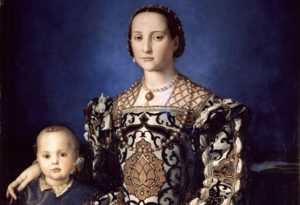New Light on Eleonora di Toledo at a Pitti Show

Until May 14: ELEONORA DI TOLEDO AND THE MEDICI COURT. Palazzo Pitti, Piazza Pitti, 1. Open Tuesday – Sunday from 8:15 am – 6:30 pm, closed Monday. Last entrance at 5:30 pm. Admission: €10, reduced €2.
Florence’s Palazzo Pitti, part of the Uffizi Galleries, has opened a new exhibition of over 100 exquisite artworks detailing the life of Eleonora di Toledo, Duchess Consort of Florence from 1539 to 1562. Curated by Bruce Edelstein, New York University of Florence art history professor, it is the largest-ever exhibition dedicated to Eleonora di Toledo. The collection includes pieces on loan from the Uffizi Gallery, the Louvre, the Alte Pinakothek in Munich, the National Gallery of the Marche in Urbino, and Pisa’s National Museum of the Royal Palace. The exhibition is divided into seven sections that embody the salient life of the duchess: including her childhood in Naples, arrival in Florence, family, relationship with art and fashion, and creation of the Boboli Gardens.
Wife of Cosimo I de’Medici, Eleonora is immortalized as a politically influential female power, true creator of the Boboli Gardens, and icon of fashion and beauty. She is credited with helping build the Medici court, introducing Spanish etiquette in Florence, and influenced the fashion of Florence’s elite. Also a keen businesswoman, she financed many of Cosimo’s political campaigns and was decisive in the acquisitions of important buildings such as Palazzo Pitti itself: in addition, she ruled as regent of Florence during her husband’s frequent absences. Because of this, she is recognized as the earliest modern first lady.
The collection displays numerous central works, such as the iconic portraits of Eleonora and Cosimo by Agnolo Bronzino, the Portrait of Pedro de Toledo as a Knight of the Order of Santiago by Titian (1542), the Young River God by Pierino da Vinci (1548), and a tapestry from the workshop of Nicolas Karcher. The exhibit also has numerous pieces of intact clothing on display, such as a red velvet petticoat probably belonging to one of Eleonora’s bridesmaids when she was received at the Vatican in 1560 by Pope Pius IV.
Born in Alba de Tormes, Salamanca, Spain, in 1522 to Pedro Alvarez de Toledo and Maria Osoria, 2nd Marquise of Villafranca, Eleonora and her family moved to Italy in 1534 after her father was appointed as the Viceroy of Naples. During her childhood in Naples, her love for nature and outdoor space grew, since her father commissioned several gardens and residences there.
A 14-year-old Eleonora first met 16-year-old Cosimo de’Medici during his 1535 visit to Naples. In 1538, Cosimo, now the Duke of Florence, was searching for a wife that could strengthen his political status and stabilize the power of the Medici family with their new ducal status. Eleonora’s father, the Viceroy of Naples, offered one of his daughters, which would provide the Medici with a powerful association with Spain. As he remembered Eleonora, Cosimo refused to marry the rather dull oldest sister Isabella and instead opted for Eleonora. They were married on March 29, 1539.
It is historically regarded that the marriage between Eleonora and Cosimo was one of love more than about expanding power. They had 11 children together, eight of whom reached maturity, thus inaugurating a new era of strength and stability for the Medici family in Tuscany.
As duchess, Eleonora eventually gained ample influence in Florence due to her involvement in politics – Cosimo trusted her political skills so much that he often consulted with her. She ruled as regent during his military campaigns in 1541, 1543, and 1551 to 1554, and his illness from 1544 to 1545. She also produced and sold many agricultural products and made donations to Florentine peasants and charities. In 1549, Eleonora purchased Palazzo Pitti as a summer retreat for the Medici, and in 1550 commissioned Tribolo to create the famed Boboli Gardens.
Since her death from tuberculosis in 1562, Eleonora’s importance to Florentine and female history has tended to be overlooked – today she is often thought of as just another consort. The new exhibition at her former home, Palazzo Pitti, hopes to revitalize her legacy as an intelligent, capable female leader. (Molly Mulvihill)
